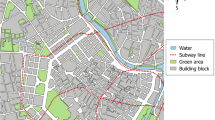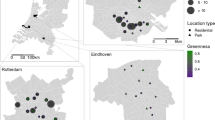Abstract
The population of Rattus norvegicus was assessed using live traps and hair sampling tubes in 71 discrete patches distributed in the urban area of the city of Salzburg, Austria. R. norvegicus occurred in 35% of the examined habitats and reached a maximum density of 113.12 individuals/km along water banks. The occurrence of rats was strongly influenced by vegetation, habitat modification and man-made impact in the area. The results of this study could be used to support the development of a new, more scientifically based rat management plan in cooperation with the city of Salzburg.




Similar content being viewed by others
References
Aitken (1989) Clinical aspects and the prevention of Q-fever in animals. Eur J Epidemiol 5:420–424
Badi MA, Iliadis N, Sarris K (1992) Natürliche und experimentelle Infektion von Nagetieren (Rattus norvegicus) mit Salmonella gallinarum. Berl Münch Tierärztl Wochenschr 105:264–267
Barnett A (1992) Expedition field techniques—small mammals (excluding bats). Expedition Advisory Centre, London
Barnett SA, Bathard AH, Spencer MM (1950) Rat populations and control in two English villages. Ann Appl Biol 38(2):444–463
Battersby SA, Webster JP (2001) Rat infestations and public health. Environ Health J 4:109–116
Battersby SA, Parsons R, Webster JP (2002) Urban rat infestations and the risk to public health. J Environ Health Res 1(2):4–12
Becker K (1950) Probleme der Rattenbekämpfung in Groß-Berlin. Anz Schädlkd 163–166
Becker k (1973) Probleme der Rattenbiologie und Rattenbekämpfung. Internationales Symposium über Fragen der Rattenvertilgung in Budapest/Ungarn. In: Beihefte der Zeitschrift für angewandte Zoologie, Heft 3. Duncker & Humbolt, Berlin
Born B (1963) Die Duisburger Rattenvernichtungsaktion und ihr Erfolg. Anz Schädlkd 667–671
Brunton CFA (1995) Neophobia and its effect on the macro-structure and micro-structure of feeding in wild brown rats (Rattus norvegicus). J Zool (Lond) 235:223–236
Brunton CFA, Macdonald DW, Buckle AP (1993) Behavioural resistance toward poison baits in brown rats, Rattus norvegicus. Appl Anim Behav Sci 38:159–174
Buckle AP, Smith RH (1994) Rodent pests and their control. CAB International, Wallingford
Calhoun JB (1949) A method of self-control of population growth among mammals living in the wild. Science 109:333–335
Calhoun JB (1962) The ecology and sociobiology of the Norway rat, P.H.S. no. 1008. U.S. Department of Health, Education and Welfare, Bethesda
Central Science Laboratory (2002) The control of rats with rodenticides: a complete guide to best practice. Central Science Laboratory, York
Cerqueira R, Freitas S (1999) A new study method of microhabitat structure of small mammals. Rev Bras Biol 59(2):219–223
Channon D, Cole M, Cole L (2000) A long-term study of Rattus norvegicus in the London Borough of Enfield using baiting returns as an indicator of sewer population levels. Epidemiol Infect 125:441–445
Chesson J (1978) Measuring preference in selective predation. Ecology 59(2):211–215
Childs JE, Glass GE, Korch GW, LeDuc JW (1989) Effects of hantaviral infection on survival growth and fertility in wild rat (Rattus norvegicus) populations of Baltimore, Maryland. J Wildl Dis 25(4):469–476
Chitty D, Kempson DA (1949) Prebaiting small mammals and a new design of trap. Ecology 30(4):536–542
Colvin BA, Degregorio R, Fleetwood C (1996) Norway rat infestation of urban landscaping and preventative design criteria. In: Timm RM, Crabb AC (eds) Proceedings of the 17th vertebrate pest conference. University of California, Davis
Davis DE (1949) The weight of wild brown rats at sexual maturity. J Mamm 39:125–130
Debinski DM, Brussard PF (1994) Using biodiversity data to assess species–habitat relationships in Glacier Nation Park, Montana. Ecol Appl 4(4):833–843
Dickman CR (1986) A method for censusing small mammals in urban habitats. J Zool (Lond) Ser A 210(4):631–636
Dickman CR, Doncaster CP (1987) The ecology of small mammals in urban habitats. I. Populations in a patchy environment. J Anim Ecol 56:629–640
Dickman CR, Doncaster CP (1989) The ecology of small mammals in urban habitats. II. Demography and dispersal. J Anim Ecol 58:119–127
Endepols S (1996) Möglichkeiten der Erfassung von Vorkommen der Wanderratte (Rattus norvegicus) und der Hausratte (Rattus rattus). Schrreihe Landschpfl und Natschutz 46:111–115
Engelbrecht H, Reichmuth CH (1997) Schädlinge und ihre Bekämpfung, Schädlingskundlicher Gesundheits- und Vorratsschutz, 3rd edn. Behr’s Verlag, Hamburg
Ferguson IR (1990) Human leptospirosis. State Vet J 44:131–144
Forbes I (1990) Rodent control in London’s sewers. J R Soc Promot Health 1:5–9
Frantz SC (1988) Architecture and commensal vertebrate pest management. In: Kundsin RB (ed) Architectural design and indoor microbial pollution. Oxford University Press, New York
Frantz SC, Davis DE (1991) Bionomics and integrated pest management of commensal rodents. In: Gorman (ed) Ecology and management of food-industry pests. Association of Official Analytical Chemists, Arlington
Fullagar PH, Jewell PA (1965) Marking small rodents and the difficulties of using leg rings. J Zool (Lond) 147:224–228
Gentile R, Fernandez FAS (1999) A field comparison of two capture–mark–recapture estimators of small mammal populations. Rev Bras Zool 16(4):1109–1114
Gollop JH, Katz AR, Rudoy RC, Sasaki DM (1993) Rat-bite leptospirosis. West J Med 159:76–77
Gurnell J (1980) The effects of prebaiting live traps on catching woodland rodents. Acta Theriol 25(20):255–264
Gurnell J, Flowerdew JR (1990) Live trapping small mammals—a practical guide, 2nd edn. The Mammal Society, London
Herold W (1953) Über Wanderbewegungen der Wanderratte (Rattus norvegicus). Anz Schädlkd 26:73–78
Kaukeinen D (1994) Rodent control in practice: householders, pest control operators and municipal authorities. In: Buckle AP, Smith RH (eds) Rodent pests and their control. CAB International, Wallingford
Keilbach R (1966) Die tierischen Schädlinge Mitteleuropas. UEB Gustav Fischer Verlag, Jena
Krebs CJ (1989) Ecological methodology. University of British Columbia, Harper Collins Publishers, New York
Krebs CJ, Singleton GR (1993) Indices of condition for small mammals. Aust J Zool 41:317–323
Kuntze A (1996) Zur Anästhesie bei Heimtieren (Kleinsäuger, Psittaciden und Reptilien). Tierärztl Pr 24:600–603
Langton SD, Cowan DP, Meyer AN (2001) The occurrence of commensal rodents in dwellings as revealed by the 1996 English House Condition Survey. J Appl Ecol 38:699–709
Lengger J, Walzer C (2003) Inhalation anaesthesia, a non rebreathing system for fieldwork. Verh Ber Erkrg Zootiere 41:379–382
Lore R, Flannelly K (1978) Habitat selection and burrow construction by wild Rattus norvegicus in a landfill. J Comp Physiol 92:888–896
Lore RK, Schultz LA (1989) The ecology of wild rats: applications in the laboratory. In: Blanchard RJ, Brain BF, Blanchard DC, Parmigiani ST (eds) Ethoexperimental approaches to the study of behavior. Kluwer Academic Publishers, Dordrecht
Lund M (1994) Commensal rodents. In: Buckle AP, Smith RH (eds) Rodent pests and their control. CAB International, Wallingford
Luzzi GA, Milne LM, Waitkins SA (1987) Rat-bite acquired leptospirosis. J Infect 15:57–60
Macdonald DW, Mathews F, Berdoy M (1999) The behaviour and ecology of Rattus norvegicus: from opportunism to kamikaze tendencies. ACIAR Monogr 59:49–80
Mason G, Littin KE (2003): The humaneness of rodent pest control. Anim Welf 12:1–37
Meyer AN (1994) Rodent control in practice: food stores. In: Buckle AP, Smith RH (eds) Rodent pests and their control. CAB International, Wallingford
Meyer AN, Shankster A, Langton SD, Jukes G (1995) National Commensal Rodent Survey 1993. Environ Health J 103(6):127–135
Mills JN, Yates TL, Kisazek TG, Peters CJ, Childs JE (1999) Long-term studies of hantavirus reservoir populations in the southwestern United States: rationale, potential, and methods. Emerg Infect Dis 5(1):95–101
Murier H, Winding O (1979) Tierische Schädlinge und andere ungebetene Tiere in Haus und Lager. Bestimmen, an ihren Spuren erkennen, bekämpfen und schützen. BLV Verlagsgesellschaft, München
Niethammer J, Krapp F (1978) Handbuch der Säugetiere Europas. Akademische Verlagsgesellschaft, Wiesbaden
Pollock KH (1981) Capture–recapture models: a review of current methods, assumptions and experimental design. Stud Avian Biol 6:426–435
Porkert J (1989) Zum Einfluß des Niederschlages und anderer Faktoren auf Fluktuationen und Artenspektrum der Kleinsäuger im Adlergebirge nach Abfängen im Wohnhaus. Lynx (Praha) 25:41–64
Quy R, Cowan DP, Haynes J, Sturdee AP, Chalmers RM, Bodley-Tickell AT, Bull SA (1999) The Norway rat as a reservoir host of Cryptosporidium parvum. J Wildl Dis 35(4):660–670
Scharfe F, Schlund W (1992) Habitatwahl bodenlebender Kleinsäuger. Veröff Landesstelle Natschutz Landschpfl Baden-Württ 67:431–437
Smith RH (1994) Rodent control methods: non-chemical and non-lethal chemical. In: Buckle AP, Smith RH (eds) Rodent pests and their control. CAB International, Wallingford
Solymar B (2001) Rodent management on farms and in new tree plantings to prevent accidental poisonings of raptors and other non-target wildlife. Ontario Barn Owl Recovery Project, Bird Studies, Canada
Southwood TRE (1978) Ecological methods, 2nd edn. Chapman & Hall, London
Spragins CW (2002) Advances in IPM rodent control in agriculture. Sustain Dev Int, Earth Summit, pp 135–140
Steininger F (1953) Wo stehen wir heute in der Rattenbekämpfung? Anzeiger für Schädlingskunde 166–168
Sutherland WJ (1996) Ecological census techniques, a handbook. Cambridge University Press, Cambridge
Sykora W (1978) Methodische Hinweise zur Kleinsäugetierforschung. Abh Ber Natkdl Mus Mauritanium Altenburg 10:1–33
Taylor KD, Quy RJ, Gurnell J (1981) Comparison of three methods for estimating the numbers of common rats (Rattus norvegicus). Mammalia 45(4):403–413
Teerink BJ (1991) Hair of west-European mammals. Cambridge University Press, Cambridge
Traweger D, Slotta-Bachmayr L (2005) Introducing GIS-modelling into the management of a brown rat (Rattus norvegicus Berk.) (Mamm. Rodentia Muridae) population in an urban habitat. J Pest Sci 78(1):17–24
Viveros MP, Hernández R (1989) Effects of social isolation and crowding on sexual behavior. Etologia 1(1–2):1–8
Voigt T (1995) Haus- und Hygieneschädlinge, 2nd edn. Govi-Verlag Pharmazeutischer Verlag, Frankfurt Main Eschborn
Webster JP, MacDonald DW (1995) Parasites of wild brown rats (Rattus norvegicus) on UK farms. Parasitology 111:247–255
Webster JP, Lloyd G, MacDonald DW (1995) Q fever (Coxiella burnetii) reservoir in wild brown rat (Rattus norvegicus) populations in the UK. Parasitology 110:31–35
Wendland V (1965) Die Wanderratte (Rattus norvegicus) als Freilandbewohner in West-Berlin und ihre natürlichen Feinde. Berl Nschbl 27:14–19
World Organisation for Animal Health (2000) An update on zoonoses. Rev Sci Tech 19(1):1–333
Author information
Authors and Affiliations
Corresponding author
Additional information
Communicated by Jürgen Gross
Rights and permissions
About this article
Cite this article
Traweger, D., Travnitzky, R., Moser, C. et al. Habitat preferences and distribution of the brown rat (Rattus norvegicus Berk.) in the city of Salzburg (Austria): implications for an urban rat management. J Pest Sci 79, 113–125 (2006). https://doi.org/10.1007/s10340-006-0123-z
Received:
Revised:
Accepted:
Published:
Issue Date:
DOI: https://doi.org/10.1007/s10340-006-0123-z




